
Сприяння розвитку дитини: Поглиблене вивчення STEM-іграшок
Вступ:
STEM-освіта (наука, технології, інженерія та математика) сприяє розвитку дитини. Вона заохочує дитячу допитливість, розвиває критичне мислення та готує їх до майбутніх досягнень у світі, що стрімко розвивається.
Наука
Наука в STEM-освіті передбачає спостереження, експерименти, запитання та прогнозування. Вона заохочує дітей досліджувати навколишній світ і розуміти, як все влаштовано.
Технологія
Технологія в STEM-освіта сприяє винахідливості та вирішенню проблем. Воно передбачає використання різних інструментів, у тому числі комп'ютерів, для того, щоб змусити речі працювати і виявити проблеми. Досвід програмування за допомогою робототехніки є перспективним інструментом для інтеграції технологій у ранньому дитинстві STEM-освіта.
Інжиніринг
Інженерія в STEM-освіті - це вирішення проблем, тестування матеріалів, проектування, створення та конструювання. Інженери відіграють вирішальну роль у заохоченні допитливості та творчості дітей, роблячи STEM цікавим і доступним через просвітницькі програми.
Математика
Математика в STEM-освіті включає в себе моделювання, послідовність і вивчення форм, чисел, об'ємів і розмірів. Сильний фундаментальна математична підготовка є ключовою для успіху STEM освіта. Такі програми, як Mathnasium, сприяють розвитку мислення учнів, підкреслюючи, що інтелект і здібності до математики можна розвинути завдяки зусиллям і практиці.
STEM-освіта виходить за рамки передачі знань; вона розвиває життєві навички, такі як творче вирішення проблем, логіка та стійкість[11]. Вона також заохочує практичне навчання, що є ефективним способом побудови впевненості дитини. Цей підхід вимагає від учителів переходу від ролі інструктора до ролі фасилітатора, що робить навчання більш активним і цікавим.
Батьки та вчителі можуть заохочувати STEM-освіту залучаючи дітей до різноманітних проєктів та заходів, які розвивають пристрасть та цікавість до STEM. Це включає в себе надання практичного досвіду, сильних рольових моделей та захопливих проблем, які мотивують дітей до навчання та розвитку.
STEM-іграшки та когнітивний розвиток
STEM-іграшки (Science, Technology, Engineering, and Mathematics - наука, технології, інженерія та математика) відіграють важливу роль у когнітивному розвитку дітей. Вони покликані розвивати творчість, критичне мислення, вміння вирішувати проблеми та навички міжособистісного спілкування.
Ці іграшки виходять за рамки простої розваги; вони пропонують інтерактивний і практичний підхід до навчання, який стимулює критичне мислення, вміння вирішувати проблеми і творчість.
Одна з основних когнітивних здібностей, яка розвивається через STEM-інтерактивні іграшки це визначення конкретних проблем. Коли дитина може сприймати проблеми, знайти правильне рішення стає легше.
STEM-іграшки можуть збагатити когнітивні навички дітей, такі як логічне мислення, вирішення проблем та критичне мислення. Вони також сприяють розвитку творчого мислення та дозволяють дітям покращити дрібну моторику.
STEM-іграшки можуть бути чудовим способом заохотити природну допитливість дитини. Вони поєднують науку, технології, інженерію та математику в цікавій формі, яка буде цікавою для дітей різного віку. Прикладами STEM-іграшок та активностей є будівельні блоки, такі як Legos або K'Nex, а також навчальні комп'ютерні ігри.
STEM-іграшки мають глибокий вплив на розвиток дітей раннього віку. Вони заохочують до спроб і помилок, експериментів та вирішення проблем. Граючись, діти вчаться адаптуватися, долати труднощі та розвивають стійкість до орієнтуватися у складному світі.
Вони також прищеплюють такі цінності, як терпіння та наполегливість. Коли діти прагнуть завершити проект, вони вчаться цінувати те, що потрібно робити доти, доки не досягнуть успіху.
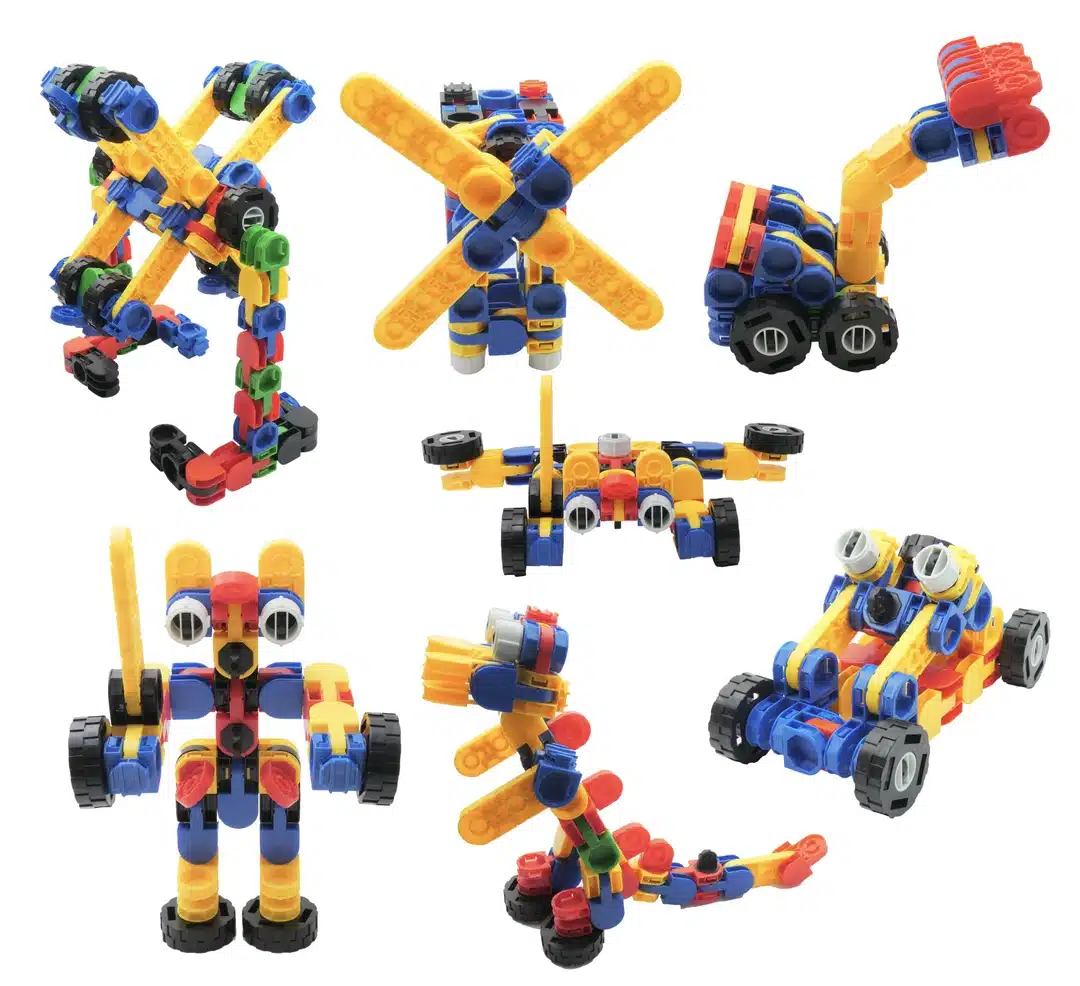
STEM-іграшки та розвиток мови
STEM-іграшки можуть зробити значний внесок у розвиток мови у дітей. Це іграшки виховують креативність, критичне мислення, вміння вирішувати проблеми та комунікативні навички.
Під час гри зі STEM-іграшками дітям часто потрібно слідувати інструкціям, описувати свої дії та пояснювати свої міркування. Цей процес може розширити їхній словниковий запас, граматику та навички вимови. Наприклад, коли діти взаємодіють з іншими під час гри з цими іграшками, вони розвивають комунікативні навички.
STEM-іграшки також можуть допомогти дітям розуміти і використовувати мову в контексті. Наприклад, коли діти використовують набори для програмування, вони вчаться писати програми, що передбачає розуміння і використання спеціальної мови, пов'язаної з кодуванням. Так само, коли діти граються з науковими наборами, вони вивчають наукову термінологію і поняття, що може покращити їхні мовні навички.
Крім того, STEM-іграшки можуть допомогти дітям розвивати рецептивні та експресивні мовні навички. Рецептивні мовні навички передбачають розуміння мови, тоді як експресивні мовні навички передбачають використання слів для самовираження. Наприклад, коли діти гратися з розвиваючими іграшкамивони вчаться виконувати інструкції (рецептивна мова) та описувати свої дії (експресивна мова).
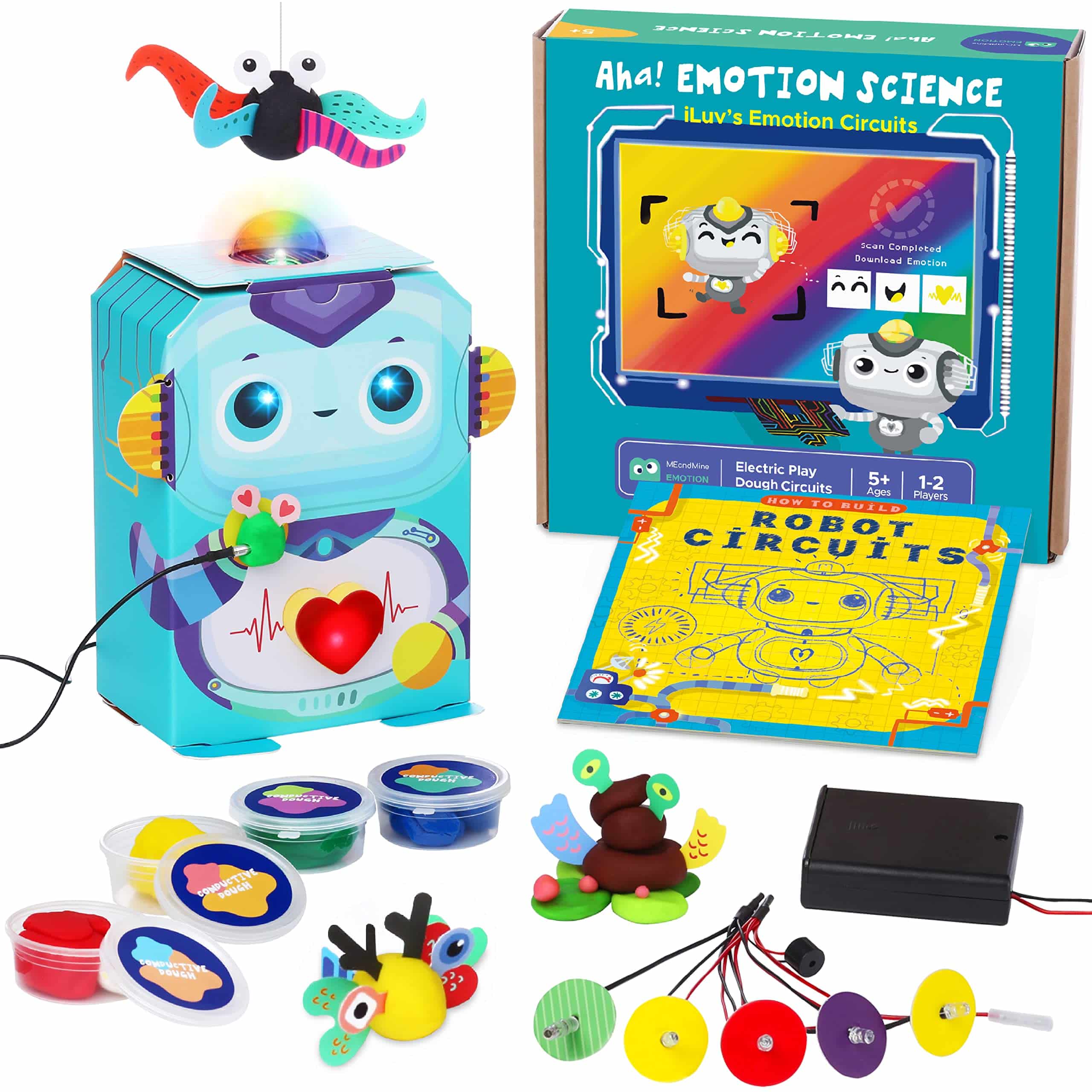
STEM-іграшки та фізичний розвиток
STEM-іграшки відіграють важливу роль у фізичному розвитку дітей, розвиваючи дрібну та велику моторику. Дрібна моторика передбачає використання дрібних м'язів кистей і пальців рук. Натомість велика моторика передбачає рух більших груп м'язів для таких видів діяльності, як повзання, ходьба та стрибки.
Розвиток дрібної моторики
STEM-іграшки часто вимагають від дітей маніпуляцій з дрібними деталями, що може покращити їхню спритність та зорово-моторну координацію. Наприклад, будівельні блокиПазли та конструктори спонукають дітей точно підбирати, розміщувати та з'єднувати маленькі деталі. Такі ігри стимулюють мозок і розвивають моторику, необхідну для письма, застібання ґудзиків та виконання інших повсякденних завдань.
Розвиток загальної моторики
Деякі STEM-іграшки також сприяють розвитку загальної моторики. Наприклад, іграшки, що передбачають фізичне кодування або побудову великих конструкцій, можуть заохочувати дітей рухатися, тягнутися, складати та балансувати, покращуючи їхнє просторове мислення та фізичну координацію.
Заохочення до активної гри
Фізичні STEM-іграшки, які є відкритими і дозволяють грати під керівництвом дитини, можуть заохотити дітей бути більш активними. Такі іграшки часто мають мало правил і дозволяють дітям використовувати свою творчість і навички вирішення проблем, щоб вигадувати ігри та вправи, які передбачають значні фізичні рухи.
Long-Term Physical Benefits
By improving motor skills, STEM toys can benefit children’s physical development. Children gain confidence in their physical abilities as they become more adept at using their hands and bodies. This confidence can encourage them to engage in more complex physical activities and challenges as they grow.
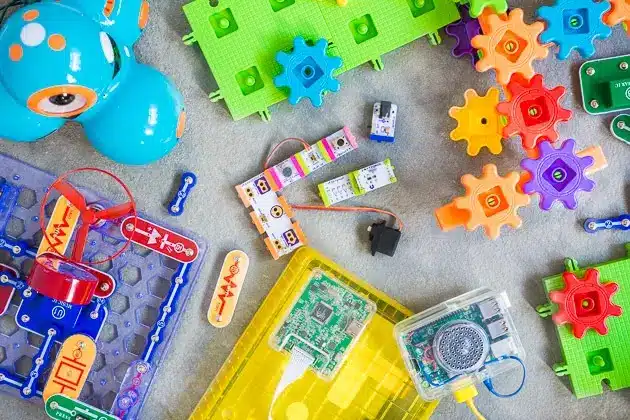
STEM-іграшки та соціальний розвиток
STEM toys can significantly contribute to the social development of children. These toys are designed to foster collaboration, communication, and interpersonal skills, which are crucial for social interaction.
Collaboration and Teamwork
Many STEM toys are designed for collaborative play, encouraging children to collaborate, share ideas, and solve problems collectively. For instance, building complex structures, working on engineering projects, or participating in group coding activities can promote teamwork. This collaborative play mirrors real-world scenarios in STEM fields, helping children understand the importance of teamwork and cooperation.
Communication Skills
Playing with STEM toys often requires children to communicate their ideas and strategies, which can enhance their verbal and non-verbal communication skills. For example, when children collaborate to build a structure or solve a problem, they must express their thoughts clearly and listen to others’ ideas. This process can improve their speaking, listening, and comprehension skills.
Interpersonal Skills
STEM toys can also help children develop essential interpersonal skills. These skills include empathy, negotiation, conflict resolution, and leadership, which are crucial for successful social interactions. For instance, when children play together with STEM toys, they may need to negotiate roles, resolve disagreements, and lead or follow others.
Confidence and Self-Esteem
Playing with STEM toys can boost children’s confidence and self-esteem. As children overcome challenges and solve problems, they gain a sense of accomplishment, enhancing their self-confidence. This confidence can, in turn, improve their social interactions and relationships.
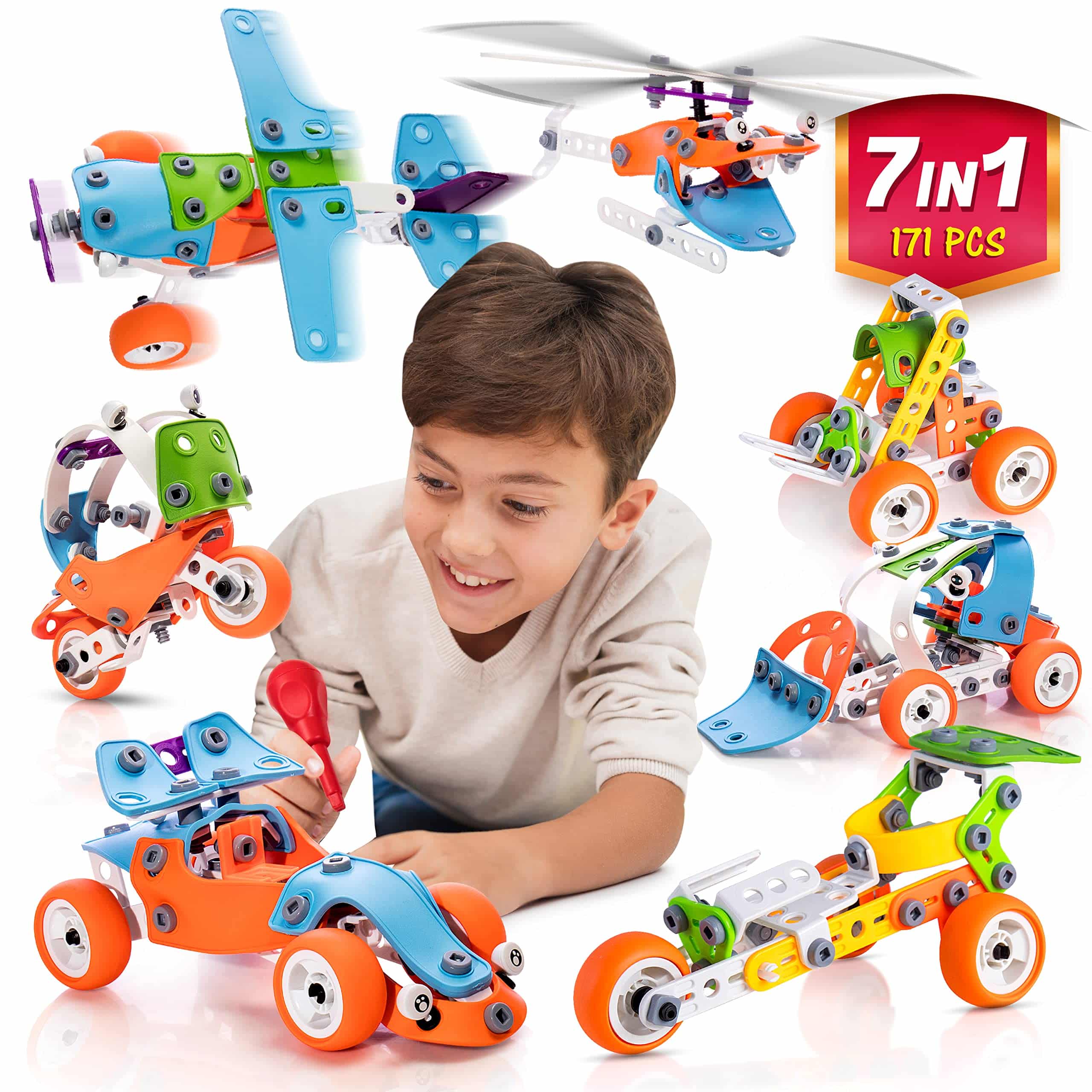
STEM-іграшки та емоційний розвиток
STEM toys can significantly contribute to the emotional development of children. They foster resilience, promote self-expression, and help children understand and manage their emotions.
Resilience and Problem-Solving
STEM toys encourage resilience through trial and error. They allow children to make mistakes and learn from them without fear of judgment, providing a safe environment where failure is seen as a stepping stone towards success. For instance, the Smartivity Try Tower is a toy that helps children become resilient and cope better with failure.
Self-Expression and Creativity
STEM toys also nurture self-expression and creativity. They inspire children to explore and express their unique ideas through hands-on play. For example, the MEandMine Emotion Science kit allows children to learn about emotions and how our body responds to them, promoting self-expression.
Emotional Understanding and Management
Some STEM toys are designed to help children understand and manage their emotions. For example, the MeAndMine Activity Kits include self-worth, decision-making, and emotional intelligence. These kits help children identify strong emotions and work through their feelings. Similarly, the Smartivity Try Tower comes with emotion badges to help children cope with their emotions after each trial.
Confidence
Playing with STEM toys can also boost children’s confidence. As they overcome challenges and solve problems, they gain a sense of accomplishment, which can enhance their self-confidence.
In summary, STEM toys contribute to emotional development by fostering resilience, promoting self-expression and creativity, helping children understand and manage their emotions, and boosting confidence. These toys provide a platform for children to learn and practice essential emotional skills in a fun and engaging way.

Типи STEM-іграшок та їх вибір
STEM (Science, Technology, Engineering, and Mathematics) toys are designed to foster learning and development in children. They come in various types and are suitable for different age groups. When selecting a STEM toy, it’s important to consider the child’s age, interests, and skill level.
Типи STEM-іграшок
- Basic STEM Toys: These include wooden будівельні блоки, colored-ring stacks, magnetic tiles, and shape sorters. Ideal for preschoolers and below, these toys teach basic concepts like counting numbers, identifying colours, and spatial reasoning.
- Microscopes and Telescopes: These toys allow children to explore the natural world in detail, fostering curiosity and scientific thinking.
- Robot Kits: Popular among older children, these kits allow children to build robots from scratch, challenging their minds to code and write programs.
- Programming Kits: These kits empower children to write programs for real-world applications, fostering logical reasoning and problem-solving skills.
- Sensory Toys: For babies and toddlers, sensory toys that focus on stimuli such as touch and sound are great for building strength, motor skills, balance, and language.
- Educational Games: These games can help children develop patience for trial and error, identify problems, and find solutions, mimicking the logical reasoning used in computer programming.
Selecting the Right STEM Toy
When choosing a STEM toy, consider the following factors:
- Age Appropriateness: Select toys that fall within your child’s age group or slightly ahead to give them something to work towards. Most toys come with a recommended age range within the product specifications.
- Interest Alignment: Consider your child’s interests. If they love spaceships, dinosaurs, or a certain cartoon character, look for STEM toys that incorporate these elements.
- Complexity Level: Start with straightforward toys, especially for beginners. More complex toys can be introduced as the child’s understanding and skills develop.
- Quality and Safety: Ensure the toy is high quality and safe for the child to use.
- Engagement Level: The toy should be engaging and fun for the child. If they enjoy playing with the toy, they are likelier to learn from it.
Освітні переваги творчих STEM-ігор
Creative STEM (Science, Technology, Engineering, and Mathematics) play offers numerous educational benefits for children. These benefits span cognitive, social, and emotional domains, fostering a holistic approach to learning.
Cognitive Benefits
1. Critical Thinking and Problem-Solving: STEM activities teach children to think critically and solve problems. These skills are not only applicable to STEM subjects but are also transferable to various life situations.
2. Innovation and Creativity: STEM play encourages innovative thinking and creativity. Children are often tasked with designing solutions to complex problems, which requires them to think outside the box.
3. Understanding Real-World Applications: STEM play helps children understand the real-world applications of science, technology, engineering, and math. This understanding can spark their interest in these fields and show them how these concepts are used in everyday life.
Social and Emotional Benefits
1. Collaboration and Communication: STEM activities often involve teamwork, which helps children develop collaboration and communication skills. They learn to work together, share ideas, and give and receive feedback.
2. Persistence and Resilience: STEM play involves a lot of trial and error, teaching children to be persistent and resilient. They learn that failure is a part of the learning process and that it’s okay to make mistakes[5].
3. Confidence Building: Successfully solving problems or completing projects during STEM play can boost children’s confidence. They gain a sense of accomplishment, encouraging them to take on more challenges.
Selecting STEM Activities for Creative Play
When choosing STEM activities for creative play, consider the child’s age, interests, and skill level. Activities should be engaging, fun, and slightly challenging to keep the child interested and promote learning. They should also align with the child’s interests to ensure they remain engaged and motivated.
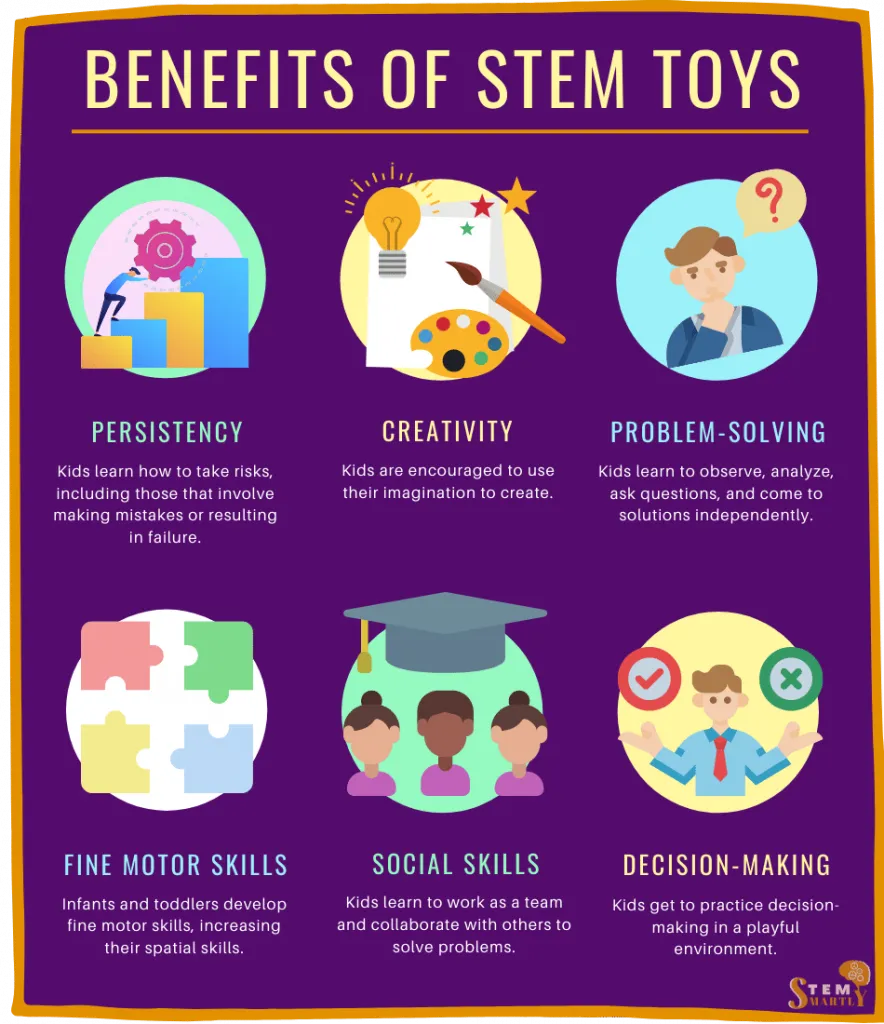
Висновок
As we reach the end of our exploration into the world of STEM toys, it’s clear that these innovative tools offer far more than just entertainment. They are a powerful means of fostering a love for learning and nurturing a wide array of skills crucial for a child’s holistic development.
This guide shows how STEM toys can enhance cognitive abilities, from logical thinking to problem-solving. We’ve discovered their role in language development, expanding vocabulary, and improving communication. We’ve also delved into their contribution to physical development, promoting fine and gross motor skills.
Moreover, we’ve highlighted the social benefits of STEM toys, from fostering cooperation and teamwork to teaching children about sharing and conflict resolution. And let’s not forget their impact on emotional development, helping children navigate the ups and downs of success and failure, building resilience, and boosting confidence.
But the most significant takeaway is the realization that STEM toys are not just about teaching science, technology, engineering, or mathematics. They are about sparking curiosity, encouraging creativity, and instilling a lifelong love for discovery. They are about preparing our children for a future where these skills will be more important than ever.
As parents and educators, our role is to provide these tools and guide our children in using them. We can unlock their full potential and empower our children’s growth by choosing the right STEM toys and integrating them thoughtfully into play and learning.
In conclusion, STEM toys are more than just playthings. They are the keys to unlocking a world of learning and discovery, setting the foundation for a brighter future. So, let’s embrace these tools and witness the incredible growth journey they can inspire in our children.
ПОШИРЕНІ ЗАПИТАННЯ
1. What exactly are STEM toys?
STEM toys are educational tools that promote learning in Science, Technology, Engineering, and Mathematics. They are designed to engage children in activities that stimulate their minds and encourage hands-on learning. These toys can range from building sets and coding robots to science experiment kits, all aimed at fostering critical thinking, problem-solving skills, and a love for learning.
2. When should children start playing with STEM toys?
There’s no hard and fast rule about when children should start playing with STEM toys. These toys are designed for all age groups, from infants to teenagers. The key is to choose developmentally appropriate toys that align with the child’s growing abilities and interests. For instance, toddlers might enjoy simple building blocks, while older children might be ready for more complex toys like coding robots or science kits.
3. How do STEM toys support language development?
STEM toys often come with instructions that require reading and understanding, which can enhance a child’s vocabulary and comprehension. They also encourage children to ask questions, express their thoughts, and communicate their ideas, all contributing to language development. For example, a child playing with a science experiment kit might need to follow written instructions, ask questions about the experiment, and explain their observations, which involve using and developing language skills.
4. Can STEM toys help with social development?
Absolutely. Many STEM toys are designed for cooperative play, which can teach children about teamwork, empathy, and the social dynamics of working with others to achieve a common goal. For instance, a group of children working on a robotics project will need to communicate effectively, delegate tasks, and work together to achieve their common goal, all of which are important social skills.
5. Where is the best place to find STEM toys for my child?
STEM toys can be found in various retail stores, educational supply shops, and online marketplaces. When selecting a STEM toy, it’s important to consider its educational value, safety, and whether it aligns with your child’s interests. Look for well-made toys with good reviews designed with children’s learning in mind. The article provides further guidance and resources for choosing the right STEM toys.
